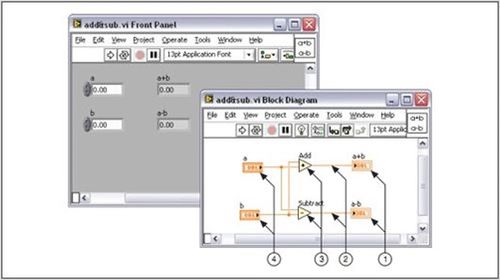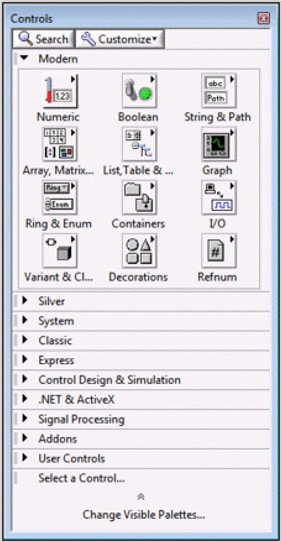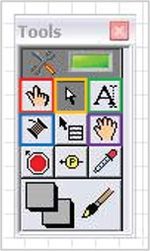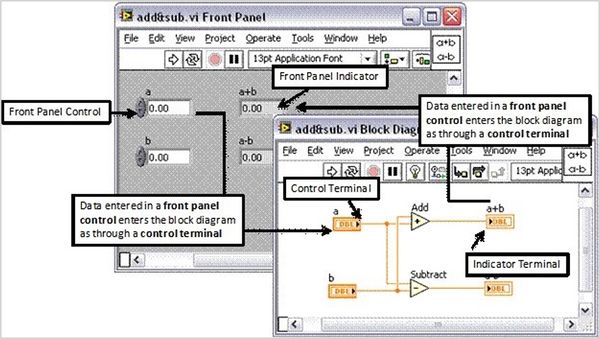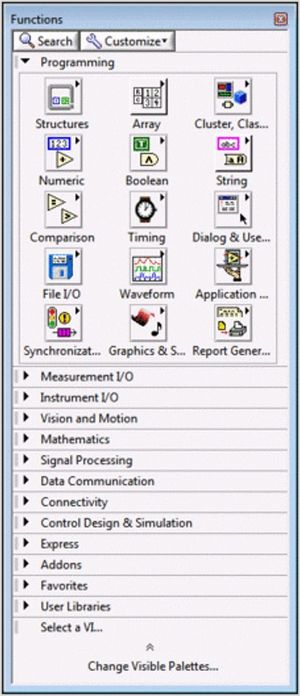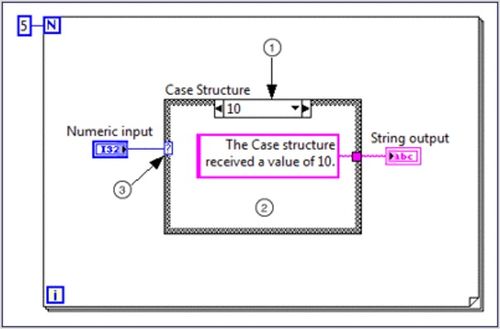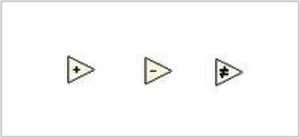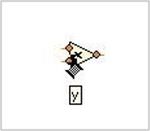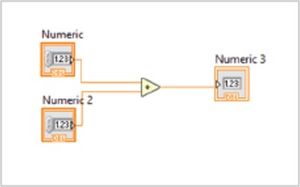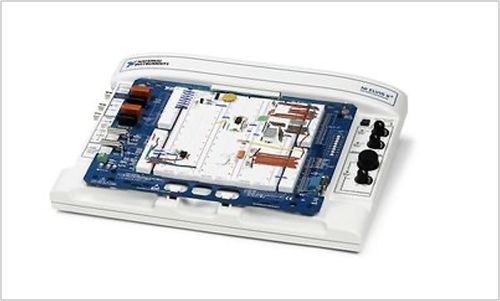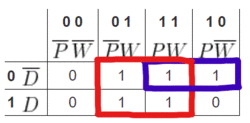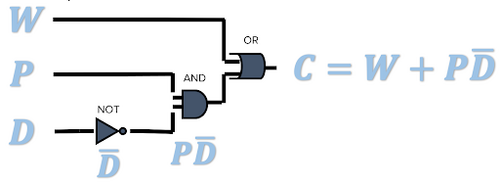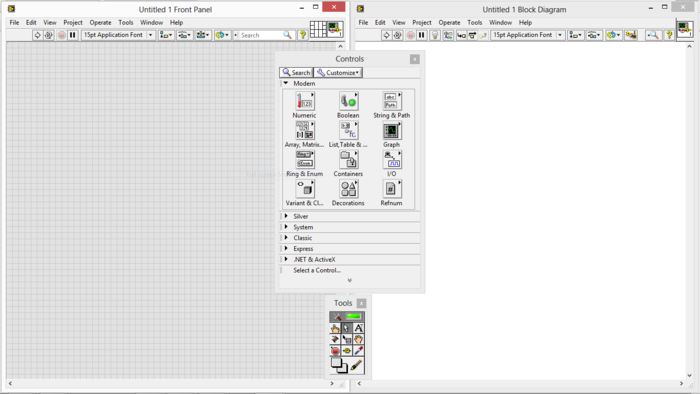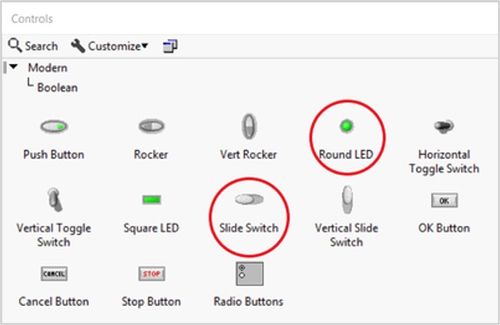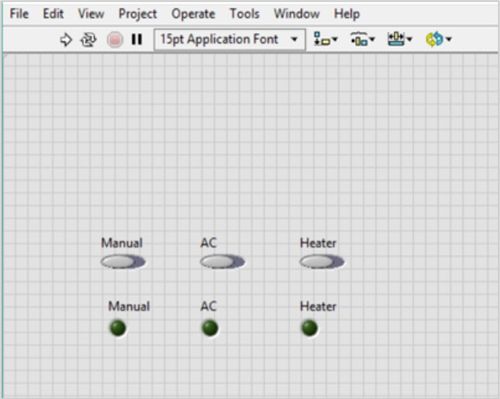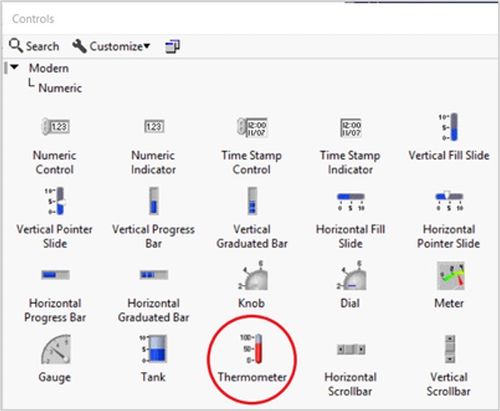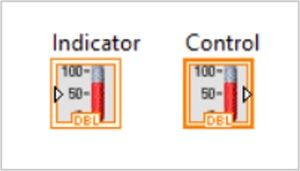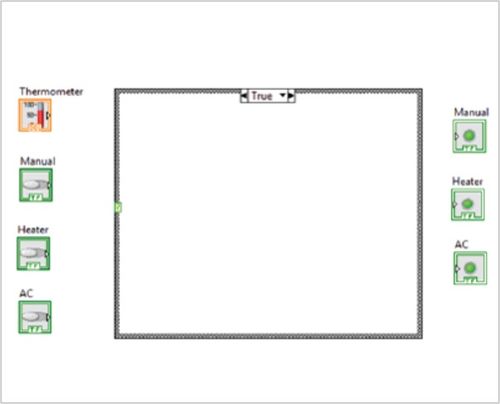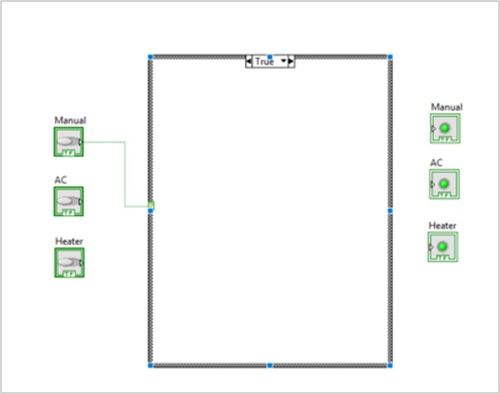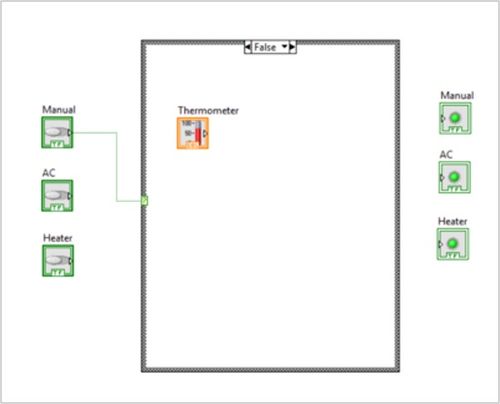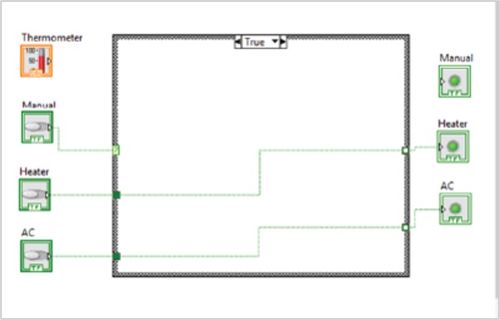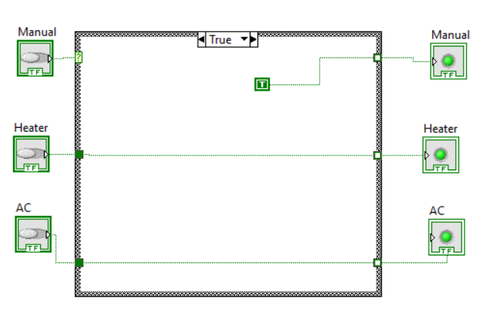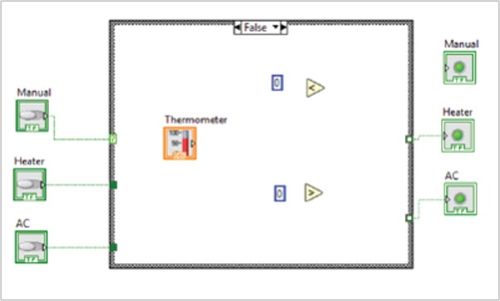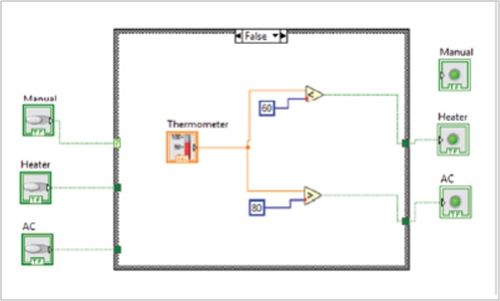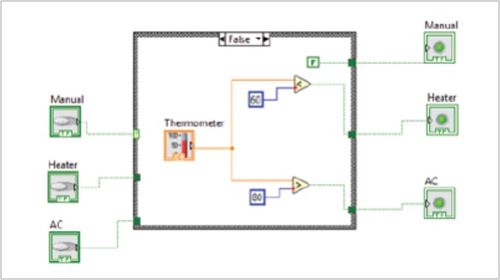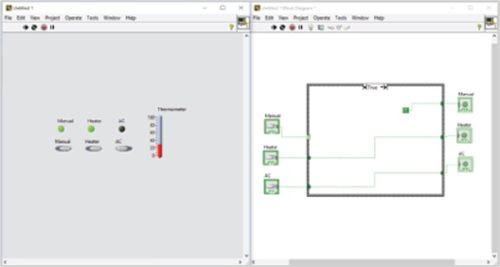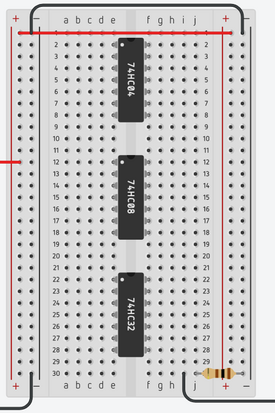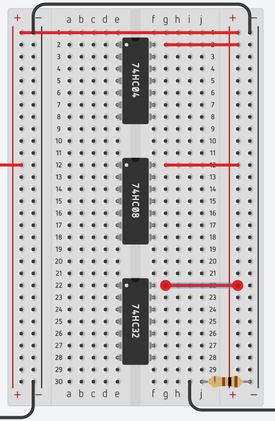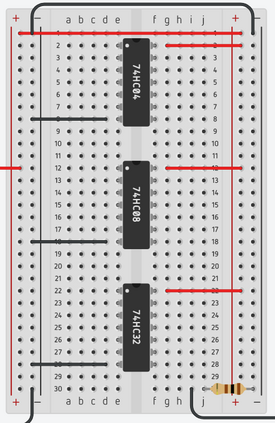Introduction to LabVIEW & Digital Logic (Virtual)
Objective
The objective of this lab is to use LabVIEW and digital logic to design a heating and cooling system and an alarm system, and to test both systems on a simulation of the NI-ELVIS II+ prototyping board. Building these systems will demonstrate the potential for using simulated instruments in a laboratory. These programs will also obtain data from outside the computer and incorporate it into a program design. The lab will be divided into two parts. Both parts of the lab focus on creating a solution for the assigned problem statement.
Overview
LabVIEW
The Laboratory Virtual Instrument Engineering Workbench (LabVIEW) is a development environment designed by National Instruments that creates graphics-based programs called virtual instruments (VI) that simulate actual laboratory instruments. A VI consists of two parts: a front panel and a back panel (Figure 1). The front panel allows the user to interact with the VI by displaying outputs and allows the user to supply the program with inputs. The back panel consists of the code used by the VI to obtain inputs from the front panel, operates on the inputs, and displays the results.
The front panel is built using controls and indicators. Controls are inputs that allow a user to supply information to the VI. Indicators are outputs that display the results based on the inputs given to the VI. Controls can be switches, knobs, dials, and buttons. Indicators can be meters, gauges, LEDs, and displays. These are located on the Controls palette and are placed on the front panel (Figure 2).
The back panel, which is also known as the block diagram, contains the graphics-based source code. The environment of the back panel is built using the Tools palette (Figure 3).
In Figure 3, only the icons in colored boxes will be used in this experiment. The operating tool changes the value of a control. The positioning tool positions, resizes, and selects objects. The labeling tool is used to create and edit all labels in the VI, such as the name of a Boolean control. The wiring tool wires objects together on the back panel. The scrolling tool allows scrolling the window by clicking and dragging.
All of the objects placed on the front panel will appear on the back panel as terminals. Terminals are basically entry and exit ports. They exchange information between the front panel and block diagram and appear with small triangles in the icons to indicate that they can be used to process information (Figure 4). A control terminal has the triangle to the right to indicate that it sends data to be processed. An indicator terminal has the triangle to the left to indicate that it receives data.
The back panel also contains structures and functions that perform operations on controls and supply data to indicators. Structures and functions are found on the Functions palette and are placed on the back panel (Figure 5).
Structures are process control elements, such as while loops and for loops. The structure to be used in this experiment is the case structure (Figure 6), which is essentially multiple if-statements. A case structure contains multiple sub-diagrams (or cases), and a case will be executed depending on the input to the case structure.
In Figure 6, Item 1 is the selector label that displays the input value that the associated case will execute. The black arrows on the side of the selector label toggle between the different cases. Item 2 is the area for the code that executes the specific input in the selector label. When the selector label is toggled, the code in this area will also change. Item 3 is the case selector, which gives the input value to the case structure. The data type that is wired to the case selector that will determine the possible cases. For example, if a Boolean data type is wired to the case selector, the possible cases will only be true and false.
Functions are the fundamental operating elements of LabVIEW and have input and output terminals to pass data in and out. They are indicated by a pale yellow background in the icon (Figure 7).
Functions have a certain number of inputs and outputs, depending on the type of function. For example, the addition function (leftmost icon in Figure 7) has two inputs as it will add the two inputs together, and it will have one output that is the sum of the inputs. The inputs are wired to the left side of the function, and the outputs are wired to the right side of the function. The number of inputs and outputs of a function can be observed by hovering over the icon with the wiring tool and observing the terminals that appear (Figure 8).
Collectively, controls, indicators, structures, and functions are referred to as nodes. Nodes are connected to one another using the wiring tool. For example, two controls and an indicator can be wired to the addition function so that the indicator displays the sum of the two controls (Figure 9). Notice how the two controls have the triangle on the right, and the indicator has the triangle on the left.
The toolbar at the top of the front panel is used to execute and stop the program (Figure 10). The run tool (white arrow) runs the program once. The run continuously tool (two white arrows in a circle) keeps the program running continuously until the program is paused or stopped. This tool should be used when executing programs in this experiment. The abort execution tool (red stop sign) stops the VI immediately. The pause button (two vertical black rectangles) pauses the program and can be clicked again to continue the program.
NI ELVIS II+ Board
National Instruments' Educational Laboratory Virtual Instrumentation Suite (NI ELVIS II+) board (Figure 11) is one solution LabVIEW can utilize to physically interface with external devices. It is a modular engineering device that includes a breadboard, power supply, ground, thermocouple, oscilloscope, function analyzer, and other common lab instruments. In this experiment, an NI ELVIS board II+ will be used to provide inputs and display outputs for the VIs that will be created. Here is a tutorial video on NI ELVIS boards II+.
Digital Logic
Digital logic is the conceptual language behind modern computer systems. It uses the Boolean language, which consists of a system of rules that essentially says “yes” or “no” to a series of questions, leading to extremely complicated decisions. The fundamentals of digital logic will be explored in this lab, and a digital logic system will be designed to address a simple problem statement.
Truth Tables
In Boolean logic, there are only two values, true and false, represented by 1 and 0, respectively. These values are combined in equations to yield results that also have these two values. The equations are represented by truth tables that show the inputs to the equation and the outputs produced for those inputs. The rows of the table contain all the combinations of 1s and 0s for the inputs. The number of rows is determined by the number of combinations.
To illustrate a truth table and additional concepts that will be introduced, think of an ATM that has three options: print a statement, withdraw money, or deposit money. The ATM will charge a fee to (1) withdraw money or (2) print a statement without depositing money. The intent of the problem is to develop a Boolean equation and logic circuit that will determine the combinations of actions will result in a fee being charged. First, a truth table should be made for all the combinations of inputs. The inputs are the ATM's three functions. Let variable P stand for printing a statement, W for withdrawing money, and D for depositing money. A “1” indicates the user has taken that action and a “0” indicates the user has not taken that action. There are two outputs -- charge a fee (1) or do not charge a fee (0). The output column will be denoted by C. The truth table in Table 1 shows all the combinations of the inputs and their corresponding outputs.
Table 1: Truth Table for the ATM Example
| Inputs | Output | ||
|---|---|---|---|
| 0 | 0 | 0 | 0 |
| 0 | 0 | 1 | 0 |
| 0 | 1 | 0 | 1 |
| 0 | 1 | 1 | 1 |
| 1 | 0 | 0 | 1 |
| 1 | 0 | 1 | 0 |
| 1 | 1 | 0 | 1 |
| 1 | 1 | 1 | 1 |
Logic Gates
Boolean logic is applied to digital circuitry through the use of simple logic gates. There are symbols for each of these gates, and the connections between them are represented by lines running from the output of one gate to the input of another. A line can connect only one output to each input. There are seven gates: the NOT, AND, OR, NAND, NOR, XOR, and XNOR gates. Only the first three will be used in this lab (Figure 12).
The NOT gate is the simplest of the three. It is an inverter. It has one input and produces its opposite as the output. For example, if a 1 is the input to a NOT gate, a 0 value is outputted, as seen in Table 2. The symbol for the operation is a horizontal bar over the variable. The truth table for a NOT gate is shown in Table 2.
| 0 | 1 |
| 1 | 0 |
The AND gate performs a multiplication operation on its inputs. If all the inputs are true, the output is also true. But if either of the inputs is false, the output is also false. An AND gate can have two or more inputs, but for this lab, it will have two inputs (denoted by A and B in Table 3). The symbol for the AND operation is a dot (·) or the two inputs one after the other with nothing between them. The truth table for an AND gate is shown in Table 3.
| 0 | 0 | 0 |
| 0 | 1 | 0 |
| 1 | 0 | 0 |
| 1 | 1 | 1 |
An OR gate performs an addition operation on its inputs. If either of the inputs is true, the output is also true. But if all the inputs are false, the output is also false. An OR gate can have two or more inputs, but for this lab, it will have two inputs (denoted by A and B in Table 4). The symbol for the OR operation is a plus (+). The truth table for an OR gate is shown in Table 4.
| 0 | 0 | 0 |
| 0 | 1 | 1 |
| 1 | 0 | 1 |
| 1 | 1 | 1 |
Boolean Equations
A truth table is used to write a Boolean equation for a problem. All the combinations that yield an output of 1 are kept, and the equation is written. This is called a Sum of Products solution. Only the combinations that yield an output of 1 are kept because the Boolean equation intends to represent a quantitative function when the output will be true (when a fee is charged in the example of the ATM machine). The combinations that yield an output of 0 are discarded because there is no interest in when the result has a false value. The Boolean equation for the ATM example can be seen in Figure 13.
Figure 13: Boolean Equation
For each of the combinations (rows) resulting in true in Table 1, the terms of the Boolean equation are determined by multiplying the variables together (the AND operation). If an input is true, the variable can be used as-is; for an input that is false, the variable is inverted using the horizontal bar (the NOT operation). Since the output is true if any of the combinations are true, the equation is formed by using addition operations (the OR operation) on all the terms formed by the product of each combination.
Karnaugh Maps (K-Maps)
A truth table showing every combination of inputs and their corresponding outputs yields a Boolean equation that is the solution to a problem in digital logic. This equation can be simplified using a Karnaugh map (K-map). A K-map identifies and eliminates all the conditions that do not contribute to the solution. The resulting simplified Boolean equation is used to build the digital circuit and will be a combination of the logic gates described earlier.
A K-map is a two-dimensional representation of the truth table that shows the common characteristics of the inputs. For an equation with three inputs, usually all the combinations of the first two inputs are shown as four columns and the values for the third input are shown as two rows. For four inputs, all the combinations of the third and fourth inputs are shown as four rows. Only one value can change at a time in adjacent rows or columns. For example, in Table 5, the columns change from 00 to 01 to 11 to 10. Table 5 illustrates the K-map for the ATM example.
| 0 0 | 0 1 | 1 1 | 1 0 | ||
|---|---|---|---|---|---|
| 0 | 0 | 1 | 1 | 1 | |
| 1 | 0 | 1 | 1 | 0 |
Simplified Boolean Equations
To develop the simplified Boolean equation, look for the cells that have the 1 value in common. Look for cells that can physically be boxed together, where the number of cells in the box is a power of 2 (1, 2, 4, or 8 and so on). The boxes are allowed to overlap so the same cells can be used more than once. Look for the biggest boxes first, and keep finding smaller boxes until all the cells with a 1 in them are used. This means that sometimes just single cells will remain at the end. The cells in the K-map for the ATM example can be grouped like what is shown in Table 6.
In this example, all the cells containing a 1 were covered with two boxes. This means that if the conditions for either box are true, the output will be true. This also means that the simplified Boolean equation will only have two terms. The term for each box can be determined by observing which variables are constant throughout each cell of that box. For the red box, only W remains constant through the four cells. D switches from the top row to the bottom row, and P switches from the left column to the right column. For the blue box, P and remains constant through the two cells, while W switches from the left cell to the right cell. The two boxes yield the simplified Boolean equation shown in Figure 14.
This equation meets the conditions in the truth table in Table 1 and achieves the desired result with the minimum number of logic elements.
Combinational Logic Circuits
Lastly, a combinational logic circuit can be created using the simplified equation. First, a NOT operation is performed on D by inputting and outputting D through a NOT gate. Then, the P and inverted D are inputted into an AND gate, as denoted by them being multiplied in figure 14. Finally, the result of the AND operation between the P and inverted D and the W is inputted into an OR gate, as denoted by the addition function in figure 14. The final combinational logic circuit can be seen in Figure 15.
Minimization of Boolean Functions
When working with logic circuits, it is important to derive the simplified boolean expression via the k-map for the overall efficiency of the circuit. In the ATM example listed above, the simplified boolean expression in Figure 14 and drawn in Figure 15 is significantly less complex than that of Figure 13. If the ATM were to employ a circuit created from Figure 13 as versus Figure 14, the resulting software would function the exact same way; it would still be able to charge a fee under the circumstances listed by the bank. However, the process that it would undergo would take more computing power than that of the simplified version. In programming, it is typically desirable to have not only an accurate program but also the most efficient program. In more complex examples with significantly more variables, the inefficiency of cost and implementation would skyrocket.
Materials
- Computer with LabVIEW 2019 software
- TinkerCAD workspace with:
- 7432 IC (4 dual-input OR gates)
- 7408 IC (4 dual-input AND gates)
- 7404 IC (6 single-input NOT gates)
Problem Statement
Farmer Georgi owns a 350-acre dairy farm in upstate New York. In addition to milk and butter, Farmer Georgi sells fresh eggs at the Union Square Greenmarket in Manhattan. Farmer Georgi is praised for the quality of his eggs, which is a direct effect of his treating his hen well. He keeps his barns at the optimal temperature for the hen to lay eggs. It is also imperative that Farmer Georgi protects the hen that produces eggs for his business.
Part I: Heating & Cooling System
Because Farmer Georgi cares about the quality of his eggs, Farmer Georgi treats the hen with the utmost respect. The hen is most comfortable and stress-free when the temperature of the two barns are between 60°F and 80°F. Farmer Georgi needs a heating and cooling system in his barns that maintain a temperature in that optimal range.
Part II: Alarm System
Farmer Georgi has two barns, one hen, and a supply of corn. A fox has been attempting to eat the hen by hiding in a barn. The hen can move freely from one barn to the other. Farmer Georgi sometimes stores corn in one barn and sometimes in the other, but he never stores it in both at the same time. The hen would like to eat the corn and the fox would like to eat the hen. Farmer Georgi needs an alarm system that uses a digital logic circuit to protect the hen and the corn. The design should use the fewest logic gates and input variables possible. The alarm will sound if:
- The fox and the hen are in the same barn
- The hen and the corn are in the same barn
Procedure
Setting up a Blank VI
- Open LabVIEW and select Blank VI under Create Project.
- Click Window > Tile Left and Right to display the front panel (left window) and back panel (right window) side by side. This will make them visible at the same time, making it easier to work.
- With the back panel selected, click View > Tools Palette to open the Tools palette.
- With the front panel selected, click View > Controls Palette. The workspace should look like Figure 16. To open the Controls palette in the future, simply right click in the front panel. Similarly, to open the Functions palette, simply right click in the back panel.
For help with the operation of any LabVIEW icon, select Help > Show Context Help > click the icon for the operation that is unclear. It will be explained in the Context Help window.
Part I: Heating & Cooling System
Build a VI that simulates a heating and cooling system. The system must be able to be controlled manually or automatically. The VI’s specifications are listed below.
- Must be able to be controlled automatically and manually
- In manual mode, the heater and air conditioning (AC) can be switched on/off by the user
- In automatic mode, the heater and AC turn on/off based on the following conditions:
- The air conditioner is turned on when the temperature is above 80 °F
- The heater is turned on when the temperature is below 60 °F
- The heater and the air conditioner are turned off when the temperature is between 60 °F and 80 °F
1. Design the Heating & Cooling System in LabVIEW
Note: A LabVIEW digest of common tasks at the bottom of the page contains references for faster navigation.
- Follow the steps in Setting up a Blank VI to start a new VI in LabVIEW.
- In the front panel, drag and drop three Round LEDs and three Slide Switches by going to the Controls palette > Modern tab > Boolean (Figure 17). The round LEDs and slide switches will separately represent the AC, heater, and manual mode. The round LEDs will indicate if the item is on, and the slide switches will toggle the items on/off.
- Rename the LEDs and their corresponding switches to "Manual," "AC," and "Heater" to make building the system clearer (Figure 18). This can be done by using the editing text tool in the Tools palette.
- Drag and drop a thermometer (Figure 19) into the front panel (Controls palette > Modern tab > Numeric > Thermometer).
- In the back panel, right click the thermometer terminal and select Change to Control. Observe that the arrow switches from the left side to the right side (Figure 20). This makes the thermometer a control that will give an input to the program, which will be temperature.
- In the back panel, insert a case structure to control the manual and automatic operation of the heating and cooling system (Functions palette > Structures > Case Structure). To place the case structure, click once to place one corner of the case structure, and once more to place the other corner of the case structure in the back panel (Figure 21).
- Wire the Manual slide switch to the case selector on the case structure (Figure 22). This should automatically change the selector label values to True and False, if they were not already, because the slide switch is a Boolean data type. The true value corresponds to manual mode being on (where the user can directly toggle the heater and AC), and the false value corresponds to manual mode being off (where the heater and AC are automatically toggled by the system).
- Because the temperature of the barn is input into the system only when the system is not in manual mode (the false case), the thermometer terminal should be moved into the false sub-diagram (Figure 23).
- In the true sub-diagram, wire the AC and heater switches directly to their corresponding LEDs (Figure 24). This allows the switches to directly toggle their corresponding LEDs.
- Staying in the true sub-diagram, insert a True Constant (Functions palette > Programming tab > Boolean > True Constant). Wire the true constant to the manual LED to turn the manual LED on and indicate that the system is in manual mode (Figure 25).
- In the false sub-diagram, insert two Numeric Constants (Functions palette > Programming > Numeric > Numeric Constant), one 'Greater?' function and one 'Less?' function (Functions palette > Programming > Comparison). These will be used to build the program for the heating and cooling system in automatic mode (Figure 26).
- The less than and greater than functions compare what is wired to the upper input terminal to what is wired to the lower input terminal. Wire the thermometer to the upper input terminals of the less and greater functions. Set a numeric constant to 60 and the other to 80. Wire the 60 numeric constant to the lower input terminal of the less than function and the 80 numeric constant to the lower input terminal of the greater than function. Wire the output terminal of the greater than function to the AC LED and wire the output of the than less function to the heater LED (Figure 27).
- In the false sub-diagram, Insert a False Constant (Functions palette > Programming > Boolean > False Constant) and wire it to the manual LED (Figure 28). This turns off the manual LED and indicates that the system is in automatic mode.
- The system is now complete. Click the continuously run button to control and test the VI. If the continuously run button is faded out, that means the system is wired completely. When successfully running the system, the gridlines in the background of the front panel should disappear (Figure 29). Click the switches and thermometer on the front panel to test the system.
- Have a TA check the VI. Once testing is complete, take a screenshot of the VI. Save the heating and cooling system as a VI file (saving the file will save both the front panel and back panel in one file). Send the VI file to the lab participants via email.
2. Starting a New Circuit in Tinkercad
Tinkercad is an online 3D modeling program and will be used in this lab to simulate the circuits.
- Go to tinkercad.com and sign in with an Autodesk account.
- Open the Tinkercad link for the part of the lab you want to work on. The links are provided in the procedure below.
- Select the Copy & Tinker option. This will copy the template to the workspace so it can be edited.
3. Simulating the LabVIEW circuit
- Copy the Part 1 template to the Tinkercad workspace using the steps in Starting a New Circuit in Tinkercad.
- The simulation in the Tinkercad link is set to turn on the light bulb (Heater) for 5 seconds when the temperature is set to be below 60 ℉ (15 °C on Tinkercad) on the TMP 36 sensor and turn the motor (AC) on for 5 seconds when the temperature set on the sensor is above 80 ℉ (27 °C on Tinkercad).
- Run the simulation and observe how the circuit reacts by setting different values on the TMP 36 sensor to see how your logic would work if it is implemented on the NI-ELVIS II+ prototyping board. Zoom in on the TMP 36 sensor once the simulation begins to clearly see the temperatures.
Part II: Alarm System
Design and build a VI that simulates an alarm system using digital logic. The specifications for the alarm system are listed under the Problem Statement section.
1. Formulate the Simplified Boolean Equation
- The two barns must be assigned a numeric equivalent before the truth table is prepared. Use 1 for Barn A and 0 for Barn B (1 does not mean true and 0 does not mean false for the inputs). For the alarm output, use 0 to indicate that the alarm should be off, and 1 to indicate that the alarm should be on.
- On a sheet of paper or on the Zoom whiteboard, create a truth table that includes the three inputs (hen, fox, corn) and one output (alarm). Assign the input variables. Use all scenarios for hen, the corn, and the fox. For example, one possible scenario is that the hen, corn and fox are in Barn B, so place a 0 in the three input columns.
- Compute the output column. To do this, analyze the three inputs and logically determine if the alarm will sound in each scenario. Place a 1 in the output column if the alarm will sound and a 0 if it will not.
- Circle all the combinations that produce a 1 in the output column. Create a Boolean equation from this table that uses each of the input combinations that produced a true output. Refer to the Overview section if there is any confusion.
- Create a K-map. Draw a map that uses all the combinations from the Boolean equation. Use the Boolean equation to fill in the 1s and 0s on the K-map.
- Box the pairs of 1s. The 1s may only be boxed in powers of 2 starting with the largest possible combination and working down to the smallest. The outcomes that do not contribute to the solution are to be discarded.
- This process yields a simplified Boolean equation. Write this simplified Boolean equation down.
- Draw a combinational logic circuit of the simplified Boolean equation.
- Have a TA approve the steps to obtain the combinational logic circuit.
2. Build the Logic Circuit in LabVIEW
Note: A LabVIEW digest of common tasks at the bottom of the page contains references for faster navigation.
Build the logic circuit in LabVIEW 2019 using the combinational logic circuit that was drawn.
- Follow the steps in Setting up a New VI to start a new VI in LabVIEW.
- Place three switches on the front panel by going to the Controls palette > Modern tab > Boolean > select the switch. The switches will represent the hen, the corn, and the fox.
- Place a Boolean indicator on the front panel to represent the alarm or the output. Go to the Functions palette > Programming > Boolean > select the AND, NOT, and OR gates necessary for the circuit.
- Wire the gates to build the combinational logic circuit.
- Click run continuously to simulate the circuit. Once the LabVIEW program is complete, have a TA check and approve the circuit.
3. Build the circuit on Tinkercad
- Copy the Part 2 template to the Tinkercad workspace using the steps in Starting a New Circuit in Tinkercad.
- Identify each of the three IC chips as an AND, OR, or NOT gate. To do this, read the number on the chip and match it with the numbers shown in Figure 16. Look for the notch at one end of each chip to orient the chip to the diagrams in Figure 30 and to match the pins.
- Place the IC chips over the bridge on the breadboard (Figure 31).
- Power the chips. Wire the Power pin of the IC chip to the breadboard marked with “+”. Repeat this process for all three chips (Figure 32).
- Ground the chips using the same method. Wire the Ground pin of the IC chip to the Ground rail of the breadboard marked with “-”. Repeat this process for all three chips (Figure 33).
- On the smaller breadboard (Breadboard mini), the output from each switch corresponds to either Hen, Fox or Corn. Begin wiring the circuit based on the simplified Boolean equation. Remember: Points on the same row on a breadboard are connected (eg. 4F through 4J are connected on the mini breadboard).
- Continue this process until the entire circuit is wired. Insert one end of a lead into the final output of the digital logic circuit. Attach the other end of the lead to the unconnected terminal of the light bulb.
- Run the Tinkercad simulation and toggle the switches corresponding to the fox, hen, and corn. Observe the light bulb to see if the alarm lights up based on the inputs to each barn. Compare the results to the truth table to determine if the circuit is operating correctly.
The lab work is now complete. Refer to the Assignment section for the instructions to prepare the lab report.
Assignment
Individual Lab Report
Follow the lab report guidelines laid out in the EG1004 Writing Style Guide in the Technical Writing section of the manual. Use the outline below to write this report.
- Describe the problem statement regarding Farmer Georgi
- Describe how AND, OR, and NOT gates work
- What is a truth table? Explain the process for obtaining a Boolean equation from a truth table
- What is a K-map? How does it contribute to obtaining a simplified Boolean equation? To demonstrate the simplification, show what the equation would look like if terms were written for each of the true values and the simplified equation by applying the K-map. Discuss how much simpler the circuitry is as a result of applying the K-map
- Include the truth table, Boolean equation, K-map, simplified Boolean equation, and combinational logic circuit developed during the lab
- Describe how to construct a digital logic circuit using Boolean equations, K-maps, truth table etc.
- Why is there a need for the minimization of a logic design and what are the advantages?
- How does the use of a combinational logic circuit contribute to advances in technology?
- Describe how the final combinational logic circuit was obtained
- Explain how Tinkercad is useful in simulations
- Discuss LabVIEW and how does it help engineers and scientists with their work. What are its advantages and disadvantages?
- How is LabVIEW important today?
- Discuss what an NI ELVIS II+ board is
- Explain what a VI is
- What are controls and indicators?
- What are structures and functions?
- What is the front panel used for? The back panel?
- Because the procedural elements for the heating & cooling system are extensive, only briefly summarize the heating & cooling system procedure
- Did the alarm system and VI work?
- Suggest improvements for the VI
- Include a screenshot of the front and back panels of the LabVIEW VIs for the alarm system and heating & cooling system
- Discuss other possible design/procedural improvements
Remember: Lab notes must be taken. Experimental details are easily forgotten unless written down. EG1004 Lab Notes paper can be downloaded and printed from the EG1004 Website. Use the lab notes to write the Procedure section of the lab report. At the end of each lab, a TA will scan the lab notes and upload them to the Lab Documents section of the EG1004 Website. One point of extra credit is awarded if the lab notes are attached at the end of the lab report. Keeping careful notes is an essential component of all scientific practice.
Team Powerpoint Presentation
Follow the presentation guidelines laid out in the EG1004 Lab Presentation Format in the Technical Presentations section of the manual. When preparing the presentation, consider the following points.
- How does digital logic impact the world today?
- Looking into the future, how will digital logic change the world?
- Include the truth table, Boolean equation, K-map, simplified Boolean equation, and combinational logic circuit developed during the lab
- Describe the advantages and disadvantages of using LabVIEW
- Explain what a VI is
LabVIEW Digest of Common Tasks
Front Panel
- How to get a slide control:
- How to get an LED indicator:
- How to get a numeric control:
- How to get a numeric indicator:
Back Panel
- How to define an arithmetic operation:
- How to define Boolean constants (usually used to turn on/off LEDs):
- How to wire:
References
Introduction to LabVIEW, Six-Hour Course [Courseware]. (June 2003) Austin, TX: Worldwide Technical Support and Product Information, National Instruments Corporation.
“LabVIEW Block Diagram Explained.” National Instruments, National Instruments, 4 Feb. 2020, www.ni.com/en-us/support/documentation/supplemental/08/labview-block-diagram-explained.html.
“Case Structure.” National Instruments, National Instruments, 4 Feb. 2020, www.zone.ni.com/reference/en-XX/help/371361R-01/glang/case_structure/.
“LabVIEW Front Panel Explained.” National Instruments, National Instruments, 4 Feb. 2020, www.ni.com/en-us/support/documentation/supplemental/08/labview-front-panel-explained.html.
Boole, George, Encyclopedia Britannica, 2003. Encyclopedia Britannica Online. Retrieved July 29, 2003 http://www.britannica.com/eb/article?eu=82823
| ||||||||
